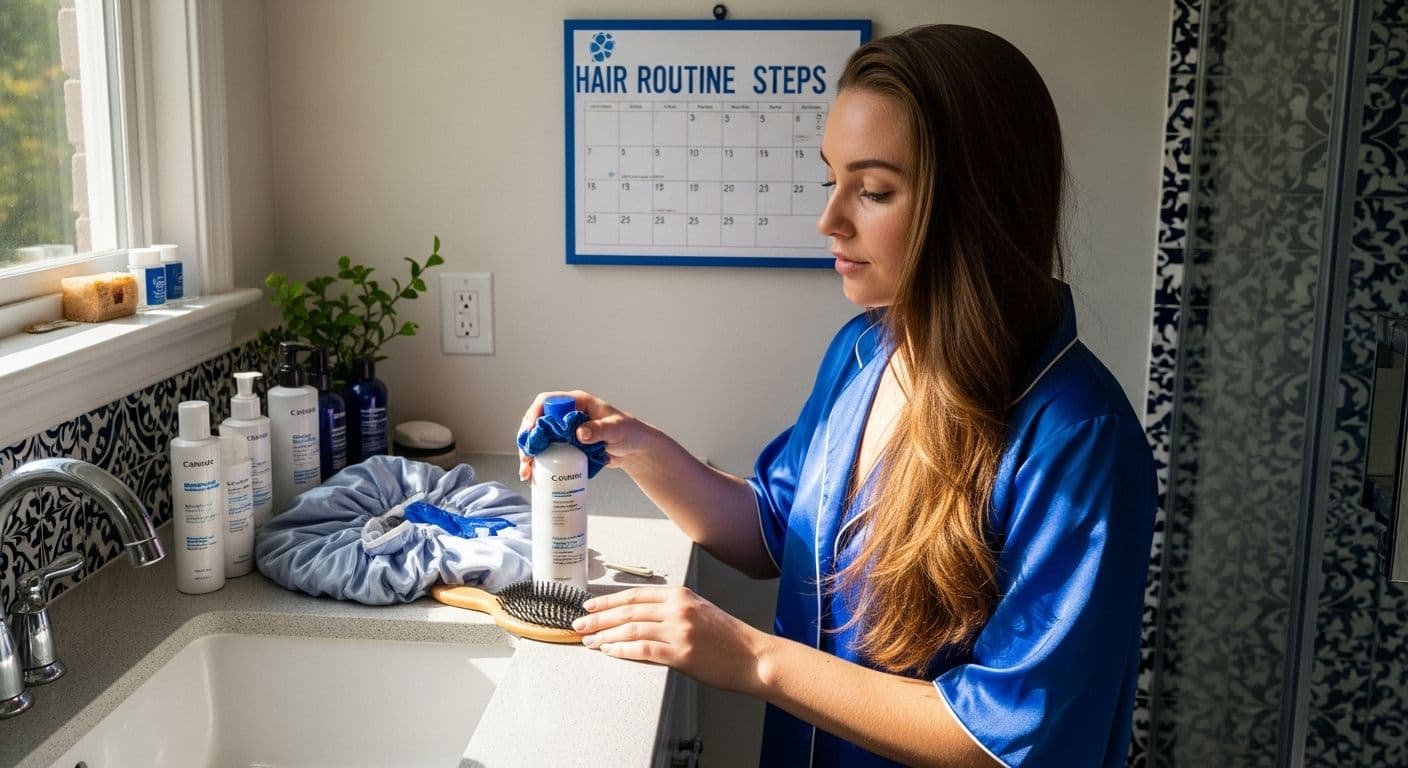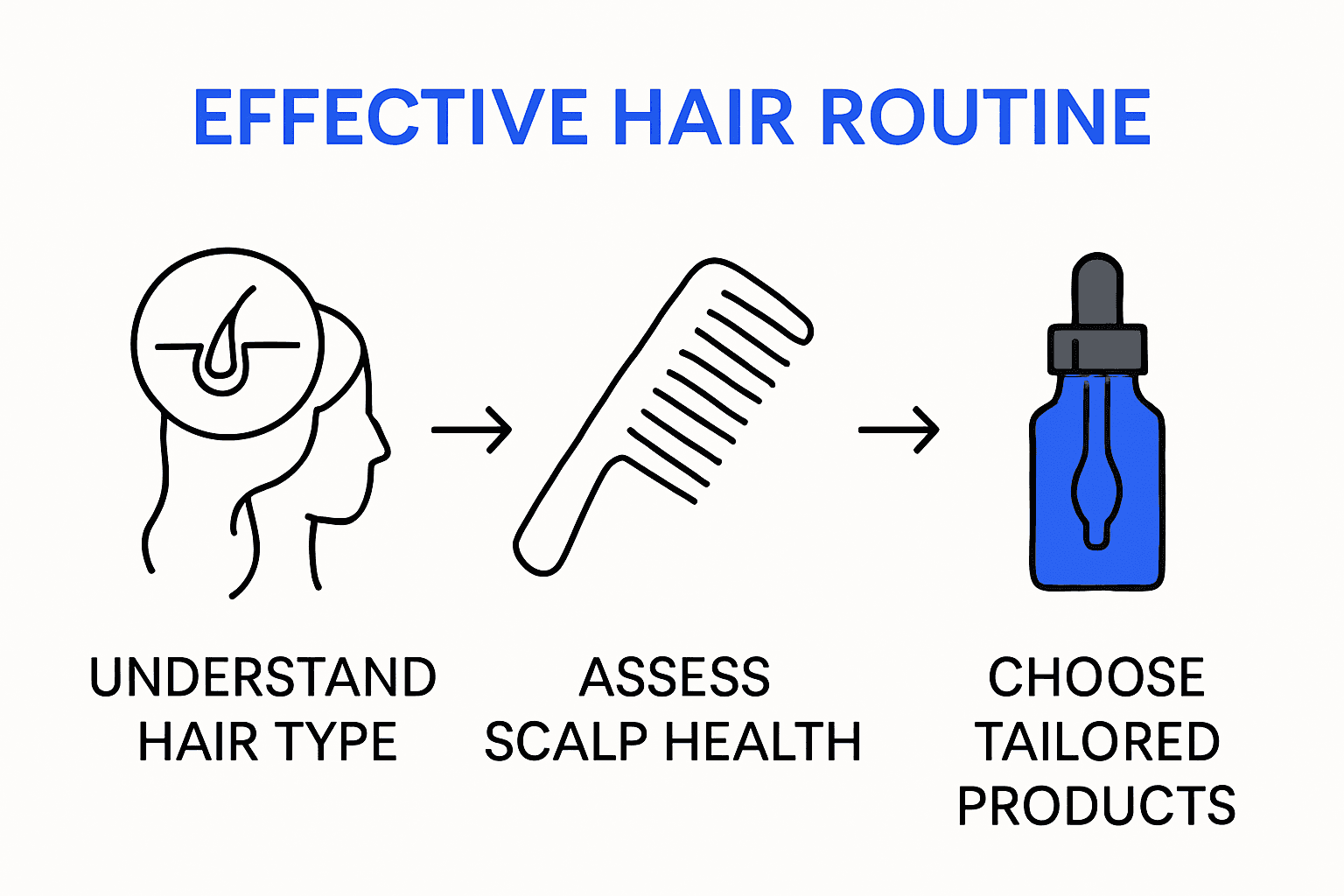Blog
Learning Materials
Hair Routine Steps for Growth and Hair Loss Care
Updated: August 9, 2025

Everyone wants thicker, stronger hair and most people believe the right shampoo alone will do the trick. Surprisingly, more than 50 percent of women and 80 percent of men experience significant hair loss at some point in life. And while most routines focus on products, the real secret starts with unlocking your unique hair type and needs. Knowing exactly what your scalp craves can be the difference between endless shedding and healthier, fuller hair.
Table of Contents
- Understanding Your Hair Type And Needs
- Essential Hair Routine Steps For Growth
- Tracking Progress And Adjusting Your Routine
- Personalized Solutions And Recommended Products
Quick Summary
| Takeaway | Explanation |
|---|---|
| Understand your hair type and porosity | Recognizing your hair's unique characteristics is crucial for effective care. Different hair types require tailored treatments to optimize health and growth. |
| Maintain a balanced scalp environment | A healthy scalp is essential for hair growth. Regularly assess sebum production, flaking, and inflammation to address any issues that might hinder growth. |
| Incorporate moisture and protection strategies | Use weekly deep conditioning and leave-in treatments to maintain hydration. Proper moisture balance prevents breakage and supports hair's structural integrity. |
| Monitor progress with systematic tracking | Regularly document hair health changes using photos and measurements. This helps identify patterns to adjust your routine effectively over time. |
| Choose personalized products tailored to your needs | Select hair products based on specific ingredients compatible with your hair type and avoid harmful additives for optimum results. |
Understanding Your Hair Type and Needs
Successful hair growth and loss prevention begin with a fundamental understanding of your unique hair characteristics. Every strand tells a story about your overall hair health, and recognizing your specific hair type is the first critical step in developing an effective hair routine.
Identifying Your Hair's Unique Characteristics
Research from the National Institutes of Health emphasizes that hair care is not a one-size-fits-all approach. Your hair's structure, texture, and scalp condition play pivotal roles in determining the most appropriate care strategy. Hair types typically fall into four main categories: straight, wavy, curly, and coily. Each type has distinct characteristics that require specialized attention.
To help you identify your hair's unique characteristics and choose the right care strategy, here's a table summarizing hair types and their key features, as described in the article:
| Hair Type | Structure/Texture | Porosity Characteristics | Care Focus |
|---|---|---|---|
| Straight | Smooth, lacks curl or wave | Often low porosity (resists moisture) | Light hydration, prevent buildup |
| Wavy | Slight, loose waves | Medium porosity (balances moisture) | Maintain moisture balance |
| Curly | Defined curls or spirals | Often higher porosity (absorbs easily) | Intensive moisture, reduce frizz |
| Coily | Tight, small coils | High porosity (quick moisture loss) | Deep conditioning, retain moisture |
This table organizes the core differences so you can quickly match your hair’s needs to appropriate care methods.
Beyond texture, understanding your hair's porosity is crucial. Hair porosity refers to your hair's ability to absorb and retain moisture, which directly impacts its health and growth potential. Low porosity hair has tightly closed cuticles that resist moisture, while high porosity hair absorbs moisture quickly but struggles to retain it. Determining your hair's porosity helps you choose the right products and treatment methods.
Assessing Scalp and Hair Health
Your scalp environment is a critical indicator of potential hair growth challenges. Factors such as oil production, sensitivity, and existing conditions like dandruff or seborrheic dermatitis can significantly impact hair growth. A healthy scalp provides the foundation for strong, resilient hair. Look for signs of scalp health including:
- Balanced Sebum Production: Neither excessively oily nor extremely dry
- Minimal Flaking: Absence of significant dandruff or skin irritation
- No Inflammation: Lack of redness or persistent itching
Tracking key scalp health indicators can help you monitor and improve your hair routine. Use the table below as a checklist to assess your scalp regularly:
| Scalp Health Factor | Description | Status (Yes/No) |
|---|---|---|
| Balanced Sebum Production | Not too oily or too dry | |
| Minimal Flaking | No significant dandruff or irritation | |
| No Inflammation | No redness or persistent itching |
Checking these regularly enables you to spot and address scalp issues early, supporting overall hair health.
Understanding these nuances allows for more targeted hair care interventions. Learn more about creating a personalized hair health strategy that addresses your specific needs.
Customizing Your Hair Routine
Once you've identified your hair type and scalp condition, developing a personalized routine becomes more straightforward. Consider factors like:
- Moisture requirements based on hair porosity
- Protein-moisture balance
- Specific styling challenges
- Genetic predispositions to hair loss
A comprehensive approach involves not just external treatments, but also considering internal factors such as nutrition, stress levels, and overall health. Regular assessment and willingness to adapt your routine are key to maintaining optimal hair health and promoting growth.
Remember, understanding your hair is a journey of discovery. What works today might need adjustment tomorrow, so remain observant and responsive to your hair's changing needs.
Essential Hair Routine Steps for Growth
Developing a comprehensive hair growth routine requires strategic planning and consistent execution. Each step plays a crucial role in promoting healthy hair development and preventing potential loss.
Foundational Hair Care Practices
According to Harvard Health, nutrition is the cornerstone of hair health. B vitamins play a pivotal role in supporting hair growth, with key nutrients found in foods like fortified cereals, trout, yogurt, and eggs. These nutrients contribute to keratin production, the protein that forms the primary structure of hair strands.
Proper hair washing technique is equally important. The Centers for Disease Control and Prevention recommends regular cleansing to remove dirt, excess oil, and product buildup. This practice prevents scalp conditions that could potentially impede hair growth. Choose a gentle shampoo that matches your hair type and focus on massaging the scalp to stimulate blood circulation.
Moisture and Protection Strategies
Hair hydration is critical for preventing breakage and promoting growth. Learn more about maintaining optimal hair moisture balance to support your hair's health. Use deep conditioning treatments weekly and apply leave-in conditioners that provide continuous moisture protection.
Healthline recommends using a wide-tooth comb for detangling, particularly when hair is wet. This method minimizes breakage and helps maintain hair's structural integrity. Apply a detangling spray or lightweight serum to reduce friction and make combing easier.
Advanced Growth Maintenance
Beyond basic care, advanced maintenance involves targeted treatments and protective styling. Consider incorporating scalp massages to enhance blood circulation, which can stimulate hair follicles. Use lightweight oils like jojoba or argan to nourish the scalp without causing excessive buildup.
Protective styling is another critical component. Minimize heat styling, use silk or satin pillowcases to reduce friction, and avoid tight hairstyles that can cause tension and potential hair loss. Trim your hair regularly to remove split ends and maintain overall hair health.
Consistent implementation of these hair routine steps creates a holistic approach to hair growth. Remember that individual results may vary, and patience is key in observing meaningful improvements in hair health and growth potential.
To help you implement an effective hair growth routine, here's a simple step-by-step summary of the essential practices described in the article:
| Step | Purpose/Benefit |
|---|---|
| Eat Nutrient-Rich Foods | Boosts keratin, strengthens and supports hair strands |
| Wash Hair Regularly | Removes buildup, prevents scalp issues |
| Use Deep Conditioning Treatments | Maintains hydration, prevents breakage |
| Detangle Gently (wide-tooth comb) | Minimizes breakage, preserves structure |
| Apply Lightweight Oils | Nourishes scalp, supports follicle health |
| Minimize Heat/Tight Styling | Reduces damage, prevents excessive shedding |
| Regular Trims | Removes split ends, promotes healthy growth |
These foundational steps work together to create a comprehensive routine for healthier, stronger hair.

Tracking Progress and Adjusting Your Routine
Monitoring hair health and growth is a dynamic process that requires consistent observation, scientific tracking, and strategic adjustments. Understanding how to effectively evaluate your hair's progress can help you optimize your routine and achieve better long-term results.
Systematic Hair Growth Monitoring
Research published in the National Institutes of Health highlights several standardized methods for tracking hair loss and growth. Implementing a systematic approach involves creating a comprehensive baseline assessment and tracking key indicators over time. Consider establishing a routine that includes:
- Regular photographs from consistent angles
- Detailed scalp and hair texture documentation
- Precise measurements of hair strand thickness
- Tracking hair shedding during washing
Documenting these metrics allows you to identify subtle changes that might otherwise go unnoticed. Explore our advanced tracking tools to streamline your monitoring process and gain deeper insights into your hair's health trajectory.
Lifestyle and Environmental Factors
According to comprehensive research on hair health strategies, lifestyle factors play a crucial role in hair growth. Beyond topical treatments, consider tracking and adjusting these broader elements:
- Stress levels and management techniques
- Nutritional intake and dietary patterns
- Sleep quality and duration
- Physical activity and circulation
The connection between overall health and hair growth is intricate. Research indicates that regular exercise can significantly improve blood circulation to the scalp, potentially supporting hair follicle health and stimulating growth.
Adaptive Routine Optimization
Successful hair care is not about rigidity but adaptability. Create a flexible framework that allows for periodic reassessment and modification. Key indicators suggesting the need for routine adjustment include:
- Persistent hair breakage
- Unusual scalp sensitivity
- Changes in hair texture or density
- Ineffective previous treatment strategies
Consider consulting with hair care professionals every three to six months to evaluate your progress and receive personalized recommendations. Remember that hair health is a continuous journey of understanding and adaptation.
By maintaining a systematic, holistic approach to tracking and adjusting your hair routine, you create an environment that supports consistent growth and long-term hair health. Patience, detailed observation, and willingness to modify your strategy are the cornerstones of successful hair care.
Personalized Solutions and Recommended Products
Personalized hair care is not a luxury but a necessity in addressing individual hair health challenges. With advancements in technology and scientific understanding, tailored solutions have become increasingly sophisticated and accessible.
Advanced Treatment Modalities
A clinical trial published in the Journal of Drugs in Dermatology demonstrated remarkable results using AI-driven personalized treatment approaches. The study revealed that customized regimens including topical serums, specialized shampoos, oral supplements, and marine collagen peptides can significantly improve hair growth, coverage, and thickness.
Explore our personalized hair assessment tools to understand how targeted interventions can address your specific hair concerns. These solutions go beyond generic treatments, offering precision-based strategies that consider your unique hair profile.
Holistic Treatment Approaches
Research from Medscape highlights innovative physical and mechanical modalities for hair growth. These techniques include:
- Scalp massage techniques
- Low-level laser therapy (LLLT)
- Microneedling procedures
- Targeted stem cell activation methods
These approaches work by stimulating blood flow, recruiting growth factors, and activating dormant hair follicles. The key is understanding that hair growth is a complex biological process requiring multifaceted interventions.
Strategic Product Selection
Selecting the right products involves more than reading labels. Consider these critical factors:
- Ingredient compatibility with your specific hair type
- Clinically validated growth-promoting compounds
- Absence of potentially harmful chemical additives
- Alignment with your scalp's unique microenvironment
Pay special attention to ingredients like biotin, keratin, peptides, and natural botanical extracts known for supporting hair health. Remember that what works for one person might not be optimal for another.
The future of hair care lies in personalization. By combining technological insights, scientific research, and individual assessment, you can develop a comprehensive strategy that addresses your unique hair growth challenges. Continuous monitoring, willingness to adapt, and a holistic approach are your most powerful tools in achieving optimal hair health.

Frequently Asked Questions
What are the essential steps in a hair growth routine?
The essential steps in a hair growth routine include eating nutrient-rich foods, washing hair regularly, using deep conditioning treatments, gently detangling with a wide-tooth comb, applying lightweight oils, minimizing heat and tight styling, and getting regular trims to remove split ends.
How can I identify my hair type and porosity?
You can identify your hair type by assessing its structure (straight, wavy, curly, or coily) and texture. For porosity, conduct a water test: place a strand of hair in a glass of water; low porosity hair will float, medium porosity will sink slowly, and high porosity hair will quickly sink, indicating its moisture absorption ability.
What kind of products should I use for my specific hair type?
Choose products that are tailored to your hair type and porosity. For low porosity hair, look for lightweight moisturizers that won’t weigh hair down. For high porosity hair, opt for richer conditioners and oils that can help retain moisture. Always check for clinically validated ingredients that support hair health.
How often should I monitor my hair health and growth?
It is recommended to monitor your hair health and growth systematically every few weeks. Take photos, document changes in hair texture, and observe any shedding during washing. This helps in adjusting your routine and targeting any issues as they arise.
Take Control of Your Hair Growth Journey With Personalized Solutions
You read about the frustration of guessing your hair type, the confusion around finding the right treatments, and the stress of dealing with unpredictable hair loss. There is no one-size-fits-all hair care plan. Your scalp, hair texture, and growth patterns are unique. That is why tracking your progress and choosing tailored solutions matter so much. Too often, generic advice and products fail to deliver results that last.

Now imagine if you could get expert-level analysis without the guesswork. With MyHair.ai, you upload a scan of your scalp and let advanced AI technology break down your hair health in detail. Instantly see how your growth patterns stack up and get real-time recommendations for products made for your needs. Stop wasting time on the wrong routines or worrying that you are missing out on better solutions. For the first time, you can understand every stage of your hair transformation with personalized hair assessment tools that put your goals front and center. Start tracking your journey and discover effective steps toward visible growth. Visit MyHair.ai now and experience a truly customized approach for your healthiest hair yet.